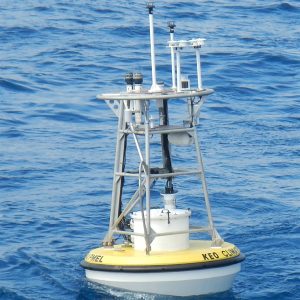Mixed-layer carbon cycling at the Kuroshio Extension Observatory
 A study published in Global Biogeochemical Cycles contributes evidence that the Kuroshio Extension transition zone is a biological hot spot for carbon cycling within the North Pacific carbon sink region.
A study published in Global Biogeochemical Cycles contributes evidence that the Kuroshio Extension transition zone is a biological hot spot for carbon cycling within the North Pacific carbon sink region.
Researchers used data recorded over seven years at the NOAA Kuroshio Extension Observatory surface mooring in the North Pacific Ocean. NOAA maintains this mooring in addition to the Station Papa buoy near Alaska to measure carbon dioxide in the sea surface and atmospheric boundary layer.
Authors in this study stated that it is still unclear how other processes, such as ocean eddies, influence carbon cycling.
Physical and biological processes occurring in the ocean are responsible for continuously cycling carbon between the atmosphere and the ocean, which sequesters, or absorbs, a major part of the atmospheric carbon dioxide.
This study was supported by the Ocean Observing and Monitoring Division.
Abstract
Seven years of data from the NOAA Kuroshio Extension Observatory (KEO) surface mooring, located in the North Pacific Ocean carbon sink region, were used to evaluate drivers of mixed-layer carbon cycling. A time-dependent mass balance approach relying on two carbon tracers was used to diagnostically evaluate how surface ocean processes influence mixed-layer carbon concentrations over the annual cycle. Results indicate that the annual physical carbon input is predominantly balanced by biological carbon uptake during the intense spring bloom. Net annual gas exchange that adds carbon to the mixed layer and the opposing influence of net precipitation that dilutes carbon concentrations make up smaller contributions to the annual mixed-layer carbon budget. Decomposing the biological term into annual net community production (aNCP) and calcium carbonate production (aCaCO3) yields 7 ± 3 mol C m−2 yr−1 aNCP and 0.5 ± 0.3 mol C m−2 yr−1 aCaCO3, giving an annually integrated particulate inorganic carbon to particulate organic carbon production ratio of 0.07 ± 0.05, as a lower limit. Although we find that vertical physical processes dominate carbon input to the mixed layer at KEO, it remains unclear how horizontal features, such as eddies, influence carbon production and export by altering nutrient supply as well as the depth of winter ventilation. Further research evaluating linkages between Kuroshio Extension jet instabilities, eddy activity, and nutrient supply mechanisms is needed to adequately characterize the drivers and sensitivities of carbon cycling near KEO.